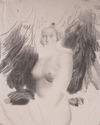
19th, 20th & 21st Century Fine Prints
707-546-7352 · fax 707-546-7924 · web: www.annexgalleries.com · email: artannex@aol.com
Max Svabinsky Biography
Max Svabinsky
Czechoslovakian
1873–1952
Biography
Printmaker, painter and graphic artist Max Svabinksky was born on September 17, 1973, in Kromeriz, then a part of Czechoslovakia. Svabinsky is celebrated in the Czech Republic as one of the country's most prominent artists with a world wide reputation, a leader in Symbolist and Realist art and graphics, considered to day to be one of the founders of Modernism in Eastern Europe. He was also a figure of particular personal admiration, having been born into relative poverty and rising through the ranks of the art world to become a renowned printmaker.
Svabinsky was inspired to pursue art from an early age, being surrounded by the flora and fauna of the Baroque Flower Gardens and other landmarks of natural beauty found in Kromeriz. He was known to hide from the Palace gardeners in order to take specimens for study, much to their chagrin. However, these auto-didactic studies of the botanic world proved fateful for the young artist, as he began selling his drawings at a local pharmacist at the age of ten. Formal lessons began with mentorships under J. Marak and Eduard Karel in printmaking, followed by studies at the Prague Academy (completed in 1898), applying and being accepted based on the merit of his portfolio alone. At the turn of the century he begun to establish his reputation as a printmaker with particular focus on mezzotint, lithography, and etching. In 1904, he won the gold medal in printmaking at the St. Louis Exhibition.
The Prague Academy offered Svabinksy a professorship in 1910, which he took, founding the school's print department and becoming it's director, a position he would keep until 1927. In 1910 he also compeleted his first commissioned murals for the government's Municiple House. For the next twenty years he continued to research and improve his skills in printmaking, adding woodengraving to his oeuvre as well as stained-glass design, postage stamp and banknote design, and further mural painting for churches and other landmarks. Of note was Svabinsky's continued acceptance in the changing political tides of the country as World War II approached, ended, and the country came under communist rule: though he was considered a Modernist -- which would come under great scrutiny, often at the cost of an artist's career, by the government -- his work had been founded in classical roots and he was therefor allowed to continue to work. Along with twenty-seven other Czechoslovakian artists he was awarded the "National Artist" title in 1945.
Svabinsky lived and worked in Kozlov for the second half of his career, and he died there on February 10, 1962.

